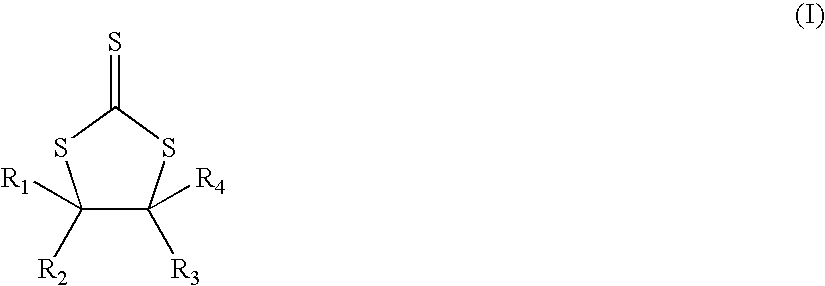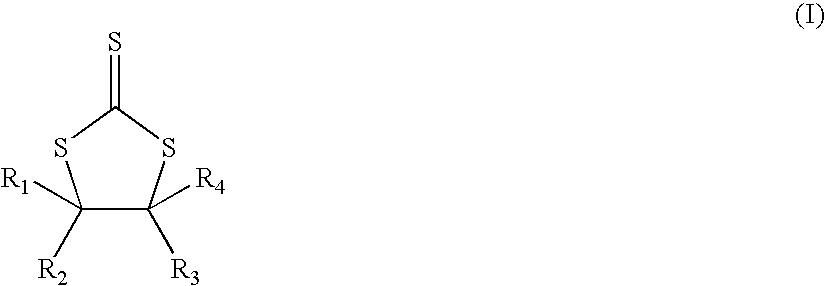1,3 dithiolane-2-thione additives for lubricants and fuels
a technology of dithiolane and dithiol, which is applied in the field of fuels, can solve the problems of increasing the level of halogen present, limiting the service life of the catalytic converter that is used, and the use of alkyl halides in the preparation of lubricant additives is now environmentally undesirable, so as to improve the solubility of the additive, improve the solubility, and facilitate the preparation
- Summary
- Abstract
- Description
- Claims
- Application Information
AI Technical Summary
Benefits of technology
Problems solved by technology
Method used
Image
Examples
example 1
Hexahydro-1-3-benzodithiole-2-thione
[0120]A 250 mL 3-neck flask was charged with 2.96 grams of sodium hydroxide and 6 mL of water. 1-Butanol, 80 mL, was added, followed by 8.9 mL of carbon disulfide. The mixture was stirred, then 7.50 mL of cyclohexene oxide was added, and a mild exotherm was noted. The mixture was stirred with heating at 35-45° C. for 90 minutes, and then heated to 70° C. and stirred for 3 hours. The mixture was allowed to stand at room temperature overnight. The product was recovered by filtration, washed with water, then air and oven dried to yield 11.9 grams of fine bright yellow crystals.
example 2
4-Octyl-1,3-dithiolane-2-thione
[0121]A 100 mL 4-neck flask (equipped with an overhead stirrer, a spiral condenser vented to a caustic scrubber, and a Claisen head with a thermocouple and a nitrogen inlet) was charged with 4.4 grams of 50% sodium hydroxide and 46 grams of 1-butanol. Carbon disulfide, 4.2 grams, was added, followed by 8.6 grams of 1,2-epoxydecane. The reaction was stirred for one hour at 50° C., and then 20 mL of water was added. The organic phase was taken up in xylenes, and extracted twice with water, then dried over sodium sulfate. The mixture was filtered, and volatiles were removed by rotary evaporation to yield 9.5 grams of a yellow oil.
example 3
4-Decyl-1,3-dithiolane-2-thione
[0122]A 100 mL 3-neck flask was charged with 4.45 grams of sodium hydroxide and 4.60 grams of water. Once the sodium hydroxide was dissolved, 50 mL of 1-butanol was added. Carbon disulfide, 6.8 mL, was added over 20 minutes (26-32° C.), followed by 11.3 mL of 1,2-epoxydodecane, keeping the temperature below 33° C. The mixture was then heated to 50° C. for 2.6 hours, then stirred at 70° C. for three hours. The reaction was cooled to 20° C. and then 10 mL of water was added in two parts. The reaction was taken up in xylenes and water. The aqueous layer was removed, and the organics extracted three times with water. Volatiles were removed by rotary evaporation to yield 12.61 grams of a clear yellow oil.
PUM
| Property | Measurement | Unit |
|---|---|---|
| weight percent | aaaaa | aaaaa |
| temperature | aaaaa | aaaaa |
| weight percent | aaaaa | aaaaa |
Abstract
Description
Claims
Application Information
 Login to View More
Login to View More - R&D
- Intellectual Property
- Life Sciences
- Materials
- Tech Scout
- Unparalleled Data Quality
- Higher Quality Content
- 60% Fewer Hallucinations
Browse by: Latest US Patents, China's latest patents, Technical Efficacy Thesaurus, Application Domain, Technology Topic, Popular Technical Reports.
© 2025 PatSnap. All rights reserved.Legal|Privacy policy|Modern Slavery Act Transparency Statement|Sitemap|About US| Contact US: help@patsnap.com



